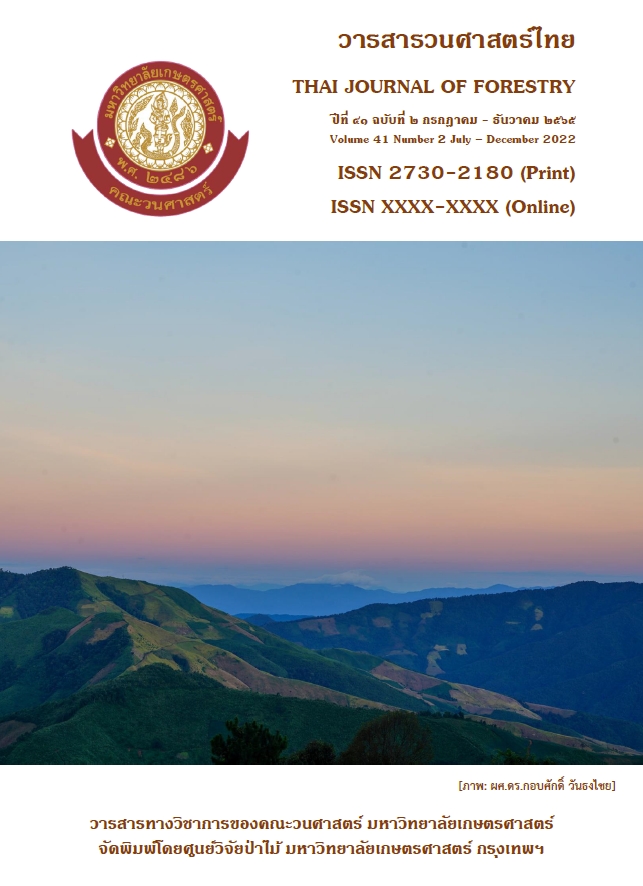การแปรผันการเติบโตและสภาวะถ่ายทอดพันธุกรรมของไม้กระถินณรงค์ ในแปลงทดสอบลูกหลาน รุ่นที่ 2 ที่สถานีวนวัฒนวิจัยกำแพงเพชร จังหวัดกำแพงเพชร
Main Article Content
บทคัดย่อ
การศึกษาในครั้งนี้มีวัตถุประสงค์เพื่อตรวจสอบการแปรผันทางการเติบโต อัตราการรอดตาย ลักษณะรูปทรง และประเมินค่าสภาวะการถ่ายทอดพันธุกรรมของไม้กระถินณรงค์ที่ปลูกในแปลงทดสอบลูกหลาน รุ่นที่ 2 ที่สถานีวนวัฒนวิจัยกำแพงเพชร จังหวัดกำแพงเพชร ที่อายุ 1-6 ปี โดยใช้แผนการทดลองแบบสุ่มในบล็อกสมบูรณ์ (RCBD) จำนวน 20 ซ้ำ แต่ละซ้ำประกอบด้วย ไม้กระถินณรงค์จำนวน 47 แฟมิลี่ (family) จาก 3 ถิ่นกำเนิด (provenance) ได้แก่ ถิ่นกำเนิดในรัฐควีนสแลนด์ (QLD) ถิ่นกำเนิดในรัฐนอร์ทเทิร์นเทอริเทอรี่ (NT) ประเทศออสเตรเลีย และถิ่นกำเนิดปาปัวนิวกินี (PNG) ทำการวัดขนาดเส้นผ่านศูนย์กลางเพียงอก (DBH) ความสูง (H) ปีละ 1 ครั้ง จนมีอายุ 6 ปี และประเมินลักษณะรูปทรงของไม้กระถินณรงค์ทุกต้นเมื่ออายุ 6 ปี จัดอันดับแฟมิลี่ที่อยู่ในเกณฑ์ดี 10 แฟมิลี่แรก ที่มีการเติบโต และรูปทรงดี วิเคราะห์ความแตกต่างด้วยวิธีวิเคราะห์ความแปรปรวน (ANOVA) ด้วยโปรแกรม R
ผลการศึกษาพบว่าไม้กระถินณรงค์ทั้ง 47 แฟมิลี่ ที่มีอายุ 6 ปี มีอัตราการรอดตายเฉลี่ยร้อยละ 61.32±7.29 มีขนาดเส้นผ่านศูนย์กลางเพียงอกเฉลี่ยเท่ากับ 12.65±0.86 เซนติเมตร และความสูงเฉลี่ยเท่ากับ 12.83±0.65 เมตร ส่วนใหญ่ไม้กระถินณรงค์มีลำต้นมีความโค้งงอเล็กน้อยและมีการแตกง่ามเล็กน้อยในช่วงปลายไม้ เมื่อวิเคราะห์ความแปรปรวนพบว่าที่อายุ 1, 2, 3 และ 6 ปี ขนาดเส้นผ่านศูนย์กลางเพียงอก (DBH) และความสูงของไม้กระถินณรงค์มีความแตกต่างอย่างมีนัยสำคัญยิ่งทางสถิติ (p<0.01) ส่วนสภาวะถ่ายทอดพันธุกรรม (h2) ของไม้กระถินณรงค์อายุ 6 ปีพบว่า มีค่าปานกลางถึงระดับสูง (0.2 - < 0.4) แสดงให้เห็นว่าทุกลักษณะที่ไม้กระถินณรงค์แปลงนี้ได้รับอิทธิพลจากพันธุกรรม เมื่อจัดลำดับพบว่า แฟมิลี่ที่ 20 (QLD), แฟมิลี่ที่ 15 (PNG), แฟมิลี่ที่ 36 (NT), แฟมิลี่ที่ 18 (PNG) และ แฟมิลี่ที่ 23 (QLD) เหมาะสมที่จะนำไปส่งเสริมให้กับเกษตรกรต่อไป
คำสำคัญ: การเติบโต ไม้กระถินณรงค์ การทดสอบลูกหลาน สภาวะถ่ายทอดพันธุกรรม
Downloads
Article Details

อนุญาตภายใต้เงื่อนไข Creative Commons Attribution-NonCommercial-NoDerivatives 4.0 International License.
ข้าพเจ้าและผู้เขียนร่วม (ถ้ามี) ขอรับรองว่า ต้นฉบับที่เสนอมานี้ยังไม่เคยได้รับการตีพิมพ์และไม่ได้อยู่ในระหว่างกระบวนการพิจารณาตีพิมพ์ลงในวารสารหรือสิ่งตีพิมพ์อื่นใด ข้าพเจ้าและผู้เขียนร่วม (ถ้ามี) ยอมรับหลักเกณฑ์และเงื่อนไขการพิจารณาต้นฉบับ ทั้งยินยอมให้กองบรรณาธิการมีสิทธิ์พิจารณาและตรวจแก้ต้นฉบับได้ตามที่เห็นสมควร พร้อมนี้ขอมอบลิขสิทธิ์ผลงานที่ได้รับการตีพิมพ์ให้แก่วารสารวนศาสตร์ คณะวนศาสตร์ มหาวิทยาลัยเกษตรศาสตร์ กรณีมีการฟ้องร้องเรื่องการละเมิดลิขสิทธิ์เกี่ยวกับภาพ กราฟ ข้อความส่วนใดส่วนหนึ่ง หรือ ข้อคิดเห็นที่ปรากฏในผลงาน ให้เป็นความรับผิดชอบของข้าพเจ้าและผู้เขียนร่วม (ถ้ามี) แต่เพียงฝ่ายเดียว และหากข้าพเจ้าและผู้เขียนร่วม (ถ้ามี) ประสงค์ถอนบทความในระหว่างกระบวนการพิจารณาของทางวารสาร ข้าพเจ้าและผู้เขียนร่วม (ถ้ามี) ยินดีรับผิดชอบค่าใช้จ่ายทั้งหมดที่เกิดขึ้นในกระบวนการพิจารณาบทความนั้น”
เอกสารอ้างอิง
Duangjinda, M. 2005. Genetic Animal Evaluation. Animal science, Faculty of Agriculture, Khon Kaen University. (in thai)
Eldridge, K., Davidson, J., Hardwood, C., Wyk, G.V. 1997. Eucalypt Domestication and Breeding. Oxford University Press, Oxford.
Haruthaithanasan, M., Kasem, H., Aekpong, T., Sakda, P., Aekachai, B. 2010. Potential of Leucaena leucocephala, Eucalyptus camaldulensis, Acacia mangium and Acacia hybrid (Mangium X Auriculaeformis) for energy plantation. In: Proceedings of 48th Kasetsart University Annual Conference: Plants. 3-5 February 2010, Bangkok. pp. 579-586. (in Thai)
Kliangsaard, T. 2013. Growth and tree of 3-year-old Acacia hybrid (Acacia mangium x A. auriculiformis) in Mine–spoiled Land at Phang – nga Forest Research Station, Takua Pa District, Phang–Nga Province. Faculty of Forestry, Kasetsart University. Bangkok, Thailand. (in Thai)
Kumar, R., Pandey, K.K., Chandrashekar, N., Mohan, S. 2011. Study of age and height wise variability on calorific value and other fuel properties of Eucalyptus Hybrid, Acacia auriculiformis and Casuarina equisetifolia. Biomass and Bioenergy, 35(3): 1339-1344.
Maelim, S., Khlangsap, K., Thaiutsa, B. 2017. Provenance trials of 1-year old Acacia mangium Wild. at Wang Nam Khiew Forestry Research and Training Station, Nakhon Ratchasima province. Thai Journal of Forestry, 36(2): 35-45. (in Thai).
Na Takuathung, C. 2005. Provenance Variation on Wood Quality of Acacia mangium Willd. M.Sc. Thesis, Faculty of Forestry, Kasetsart University. Bangkok, Thailand. (in Thai)
Pinyopusarerk, K 1987. Improving Acacia auriculiformisthrough selection and breeding in Thailand. In: Turnbulll, W., (Ed). Australian Acacias in Developing Countries. ACIAR Proceedings No. 16. Australian Centre for Inter-national Agricultural Research, Canberra, pp. 147-148.
Pinyopusarerk, K. 1990. Acacia auriculiformis: An Annotated Bibliography. Winrock International-F/FRED and ACIAR, Bangkok, Thailand. (in Thai)
Royampaeng, S. 2001. Growth and physiological performance of controlled Acacia auriculiformis x A. mangium hybrids. In: Proceedings of the 7th Silviccultural Seminar. 12-14 December 2001, Bangkok. (in Thai)
Tedsorn, N., Kaennak, P., Hongthong, B., Nimpira, S., Laosakun, S., Luangviriyasaeng, V. 2017. Clonal trials of intra-specific hybrids and inter-specific hybrids of Acacia Species. In: Forestry Conference 2017(2). 5-7 September 2017, Bangkok. pp. 46-54. (in Thai)
Williams, E.R., Forde C.G., Imaki J., Oelkers, K. 2021. Experimental design in practice: The importance of blocking and treatment structures. Australian & New Zealand Journal of Statistics, 63(3): 455-467.
Williams, E.R., Heng, S., Aken, K.M., Nguyen, A., Harwood, C.E. 2000. Data Plus 3: Productivity Software for Experiments. CSIRO, Canberra.


